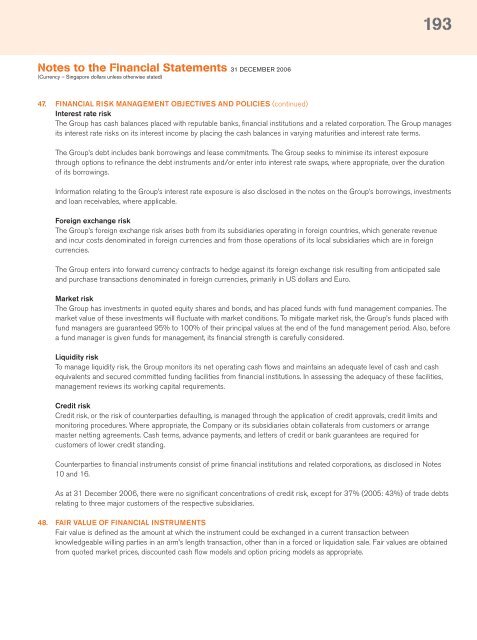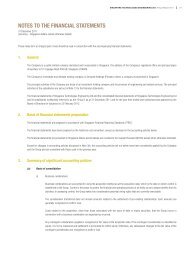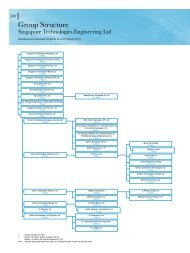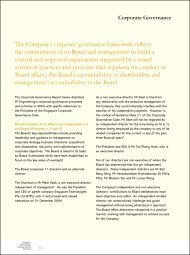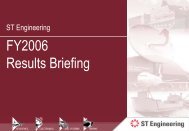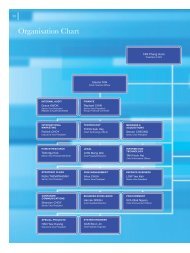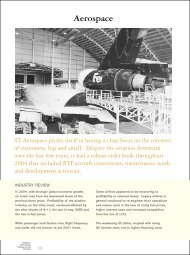Full Annual Report 2006 - Singapore Technologies Engineering
Full Annual Report 2006 - Singapore Technologies Engineering
Full Annual Report 2006 - Singapore Technologies Engineering
Create successful ePaper yourself
Turn your PDF publications into a flip-book with our unique Google optimized e-Paper software.
193<br />
Notes to the Financial Statements 31 DECEMBER <strong>2006</strong><br />
(Currency – <strong>Singapore</strong> dollars unless otherwise stated)<br />
47. FINANCIAL RISK MANAGEMENT OBJECTIVES AND POLICIES (continued)<br />
Interest rate risk<br />
The Group has cash balances placed with reputable banks, financial institutions and a related corporation. The Group manages<br />
its interest rate risks on its interest income by placing the cash balances in varying maturities and interest rate terms.<br />
The Group’s debt includes bank borrowings and lease commitments. The Group seeks to minimise its interest exposure<br />
through options to refinance the debt instruments and/or enter into interest rate swaps, where appropriate, over the duration<br />
of its borrowings.<br />
Information relating to the Group’s interest rate exposure is also disclosed in the notes on the Group’s borrowings, investments<br />
and loan receivables, where applicable.<br />
Foreign exchange risk<br />
The Group’s foreign exchange risk arises both from its subsidiaries operating in foreign countries, which generate revenue<br />
and incur costs denominated in foreign currencies and from those operations of its local subsidiaries which are in foreign<br />
currencies.<br />
The Group enters into forward currency contracts to hedge against its foreign exchange risk resulting from anticipated sale<br />
and purchase transactions denominated in foreign currencies, primarily in US dollars and Euro.<br />
Market risk<br />
The Group has investments in quoted equity shares and bonds, and has placed funds with fund management companies. The<br />
market value of these investments will fluctuate with market conditions. To mitigate market risk, the Group’s funds placed with<br />
fund managers are guaranteed 95% to 100% of their principal values at the end of the fund management period. Also, before<br />
a fund manager is given funds for management, its financial strength is carefully considered.<br />
Liquidity risk<br />
To manage liquidity risk, the Group monitors its net operating cash flows and maintains an adequate level of cash and cash<br />
equivalents and secured committed funding facilities from financial institutions. In assessing the adequacy of these facilities,<br />
management reviews its working capital requirements.<br />
Credit risk<br />
Credit risk, or the risk of counterparties defaulting, is managed through the application of credit approvals, credit limits and<br />
monitoring procedures. Where appropriate, the Company or its subsidiaries obtain collaterals from customers or arrange<br />
master netting agreements. Cash terms, advance payments, and letters of credit or bank guarantees are required for<br />
customers of lower credit standing.<br />
Counterparties to financial instruments consist of prime financial institutions and related corporations, as disclosed in Notes<br />
10 and 16.<br />
As at 31 December <strong>2006</strong>, there were no significant concentrations of credit risk, except for 37% (2005: 43%) of trade debts<br />
relating to three major customers of the respective subsidiaries.<br />
48. FAIR VALUE OF FINANCIAL INSTRUMENTS<br />
Fair value is defined as the amount at which the instrument could be exchanged in a current transaction between<br />
knowledgeable willing parties in an arm’s length transaction, other than in a forced or liquidation sale. Fair values are obtained<br />
from quoted market prices, discounted cash flow models and option pricing models as appropriate.


